Saturated Lipids Saturated Lipids Found in Beef
ix Lipids
- Lipids
- Dietary fat and its function in your torso
- Foods that contain saturated and unsaturated fats
- Health risks associated with too much dietary fat
Introduction
This chapter will learn about the iii main types of lipids and their functions in our bodies. In the trunk, fat functions equally an important depot for energy storage offers insulation and protection and plays important roles in regulating and signaling. Big amounts of dietary fat are not required to run across these functions considering they can synthesize about fatty molecules from other organic molecules like carbohydrates and protein (except for two essential fatty acids). Nevertheless, fat also plays unique roles in the nutrition, including increasing the absorption of fat-soluble vitamins and contributing to food season and satisfaction. Permit's take a closer look at each of these fats' functions in the body and the diet. Permit'south begin by watching the video below for a brief introduction to lipids.
What is Lipid?
Lipids are important fats that serve different roles in the human body. The three master types of lipids are triacylglycerols (also known as triglycerides), phospholipids, and sterols.
1) Triglycerides make up more than than 95 percent of lipids in the nutrition and are commonly institute in fried foods, butter, milk, cheese, and some meats. Naturally occurring triacylglycerols are found in many foods, including avocados, olives, corn, and basics. We commonly call the triglycerides in our food "fats" and "oils." Fats are lipids that are solid at room temperature, whereas oils are liquid.
ii) Phospholipids brand upwards only about two percent of dietary lipids. They are water-soluble and are found in both plants and animals. Phospholipids are crucial for edifice the protective barrier, or membrane, around your body's cells. In fact, phospholipids are synthesized in the torso to form jail cell and organelle membranes. In blood and torso fluids, phospholipids form structures in which fat is enclosed and transported throughout the bloodstream.
3) Sterols are the least common type of lipid. Cholesterol is perchance the best well-known sterol. Though cholesterol has a notorious reputation, the body gets but a minor amount of its cholesterol through food—the body produces nearly of it. Cholesterol is an important component of the cell membrane and is required to synthesize sex hormones, vitamin D, and bile salts.
What Lipids Do In the Body
Fats satisfy appetite (thedesire to eat) because they add flavor to foods. Fat contains dissolved compounds that contribute to rima oris-watering aromas and flavors. Fat too adds texture, making baked foods moist and flakey, fried foods crispy, and adding creaminess to foods like ice foam and cream cheese. Consider fat-free cream cheese; when fat is removed from the cream, much of the flavor is as well lost. As a result, it is grainy and flavorless—nothing like its full-fat counterpart—and many additives are used to replace the lost flavor.
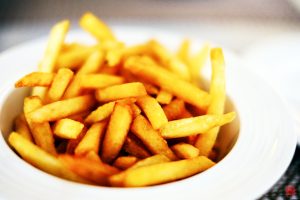
Fats satisfy hunger (theneed to consume) because they're slower to be digested and absorbed than other macronutrients. Dietary fatty thus contributes to satiety —the feeling of being satisfied or full. When fatty foods are swallowed, the body responds by enabling the processes decision-making digestion to slow the motion of food along the digestive tract, giving fats more time to exist digested and absorbed and promoting an overall sense of fullness. Sometimes, before the feeling of fullness arrives, people overindulge in fat-rich foods, finding the delectable taste irresistible. Slowing down to appreciate the taste and texture of foods can give your body time to send satiety signals to your encephalon, and then you can swallow plenty to be satisfied without feeling overly full.
Lipids perform many functions within the body:
i) Shop Free energy – When we take in more free energy than we demand, the torso stores it as adipose tissue (fatty tissue, which nosotros phone call fatty). Carbohydrates and lipids provide most of the free energy required by the human being torso. Every bit discussed in the Carbohydrates unit, glucose is stored in the body as glycogen. While glycogen provides a ready source of free energy, it is quite bulky with heavy water content, so the body cannot store much of it for long. Fats, on the other hand, can serve as a larger and more long-term energy reserve. Fats pack together tightly without h2o and store far greater amounts of energy in a reduced space. A fat gram is densely concentrated with energy, containing more than double the corporeality of energy equally a gram of carbohydrate.
We draw on the free energy stored in fat to help meet our basic free energy needs when we're at rest and fuel our muscles for movement throughout the twenty-four hour period, from walking to form, playing with our kids, dancing through dinner prep, or powering through a shift at piece of work. Historically, when humans relied on hunting and gathering wild foods or on crops' success, storing energy as fat was vital to survival through lean times. Hunger remains a problem for people worldwide, and being able to store energy when times are good can help them suffer a menstruation of food insecurity. In other cases, the energy stored in adipose tissue might allow a person to weather condition a long illness.
Unlike other trunk cells that tin can shop fat in express supplies, fat cells are specialized for fat storage and can expand almost indefinitely in size. An overabundance of adipose tissue can be detrimental to your health, from mechanical stress on the torso due to excess weight and hormonal and metabolic changes. Obesity can increase the gamble for many diseases, including blazon 2 diabetes, heart affliction, stroke, kidney disease, and certain types of cancer. Information technology can also interfere with reproduction, cognitive function, and mood. Thus, while some trunk fat is critical to our survival and proficient wellness, information technology tin can be a deterrent to maintaining good health in large quantities.
two) Regulate and Indicate – Lipids regulate the temperature of your body, keeping information technology steady, not also hot, and non too cold. Lipids as well help the body produce and regulate hormones for everything from appetite to the reproductive system to blood clotting. Lipids are key to brain construction and part; the lipids grade nerve cell membranes, insulate neurons (the cables that send messages throughout the torso), and help send signals inside the brain.
three) Insulate and Protect – Our bodies are padded with fat, protecting us from everyday friction. The average torso fat for a homo is 18 to 24 percent and for a adult female is 25 to 31 percent1. Nonetheless, adipose tissue tin can comprise a much larger percentage of bodyweight depending on the caste of obesity of the individual. Some of this fatty is stored within the abdominal crenel, called visceral fatty, and some are stored just underneath the skin, called subcutaneous fat . Visceral fat protects vital organs—such every bit the heart, kidneys, and liver. The coating layer of subcutaneous fat insulates the body from extreme temperatures and helps keep the internal climate under control. Information technology pads our hands and buttocks and prevents friction, as these areas frequently come in contact with difficult surfaces. It also gives the body the extra padding required when engaging in physically demanding activities such as ice skating, horseback riding, or snowboarding. In that location are two types of fat stored as adipose tissue: subcutaneous fat and visceral fat.
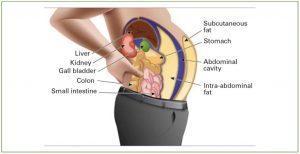
4) Aid Digestion and Increment Bioavailability – When nutrient breaks down in the gut, fat is released and combines with fat-soluble nutrients. The combination of the fat and the nutrients allows the nutrients to be digested more easily and absorbed into the body. This improved absorption is chosen increased bioavailability. Dietary fats can also increase the bioavailability of compounds known equally phytochemicals —non-essential plant compounds considered beneficial to human health. Many phytochemicals are fat-soluble, such as lycopene found in tomatoes and beta-carotene found in carrots, then dietary fat improves the assimilation of these molecules in the digestive tract.
In addition to improving the bioavailability of fat-soluble vitamins, some of the best dietary sources of these vitamins are also foods that are high in fat. For example, adept vitamin E sources are nuts (including peanut butter and other nut butter), seeds, and constitute oils such as those found in salad dressings. It isn't easy to eat plenty vitamin E if you're eating a very low-fat diet. (Although fried foods are ordinarily cooked in vegetable oils, vitamin E is destroyed by high rut and so that you won't find much vitamin E in french fries or onion rings. Your best bets are minimally-candy, whole foods.) Vegetable oils also provide some vitamin K, and fatty fish and eggs are expert sources of vitamins A and D.
Below are images of foods that contain the four fatty-soluble vitamins.
| Vitamin A | Vitamin D | Vitamin K | Vitamin East |
 | 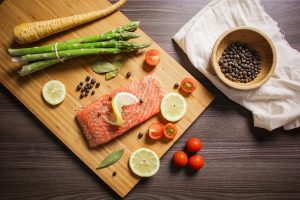 | 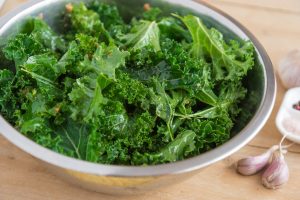 | 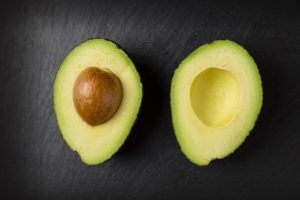 |
 | 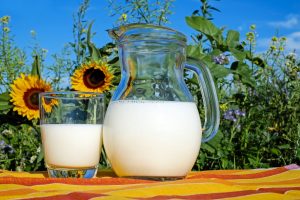 | 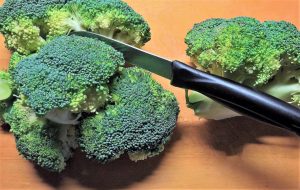 | 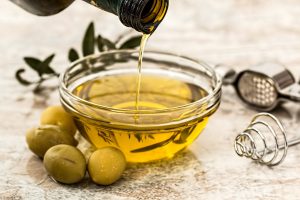 |
Vitamin A, D, K, and E are the four fat-soluble vitamins and can exist found in an array of foods like butternut squash, broccoli, and salmon. Eating dietary fat in a balanced diet helps you lot absorb these fatty-soluble vitamins, such as a kale salad with olive oil dressing and walnuts.
Nutrient Sources of Lipids
Dietary lipids are primarily oils (liquid) and fats (solid). Commonly consumed oils are canola, corn, olive, peanut, safflower, soy, and sunflower oil. Foods rich in oils include salad dressing, olives, avocados, peanut butter, nuts, seeds, and some fish. Fats are found in brute meat, dairy products, and cocoa butter.
Always recall that fats are important and can be found across the spectrum. Visit MyPlate for more data.
Saturated and Unsaturated Fats
About oils are high in monounsaturated or polyunsaturated fat and low in saturated fat. Monounsaturated fats assist regulate claret cholesterol levels, thereby reducing the risk of heart illness and stroke. Both monounsaturated fats and polyunsaturated fats provide nutrition that is essential for normal jail cell development and salubrious skin.
- Monounsaturated fat – This type of fat is found in found oils. Common sources are basics (almonds, cashews, pecans, peanuts, and walnuts) and nut products, avocados, extra virgin olive oil, sesame oil, high oleic safflower oil, sunflower oil, and canola oil.
- Polyunsaturated fat – This type of fat is plant mainly in establish-based foods, oils, and fish. Common sources are nuts (walnuts, hazelnuts, pecans, almonds, and peanuts), soybean oil, corn oil, safflower oil, flaxseed oil, canola oil, and fish (trout, herring, and salmon).
- Saturated fat – This fatty is establish in animal products, dairy products, palm and kokosnoot oils, and cocoa butter. Limit these products to less than 10 percent of your overall dietary fatty consumption. Saturated fat, which is establish in meat, dairy products, and some plant oils, is associated with increased bloodstream cholesterol. High cholesterol levels indicate that a person is at a major risk for disease, such every bit heart attack. Avoid saturated fat, or at to the lowest degree consume in moderation.
Place the following images beneath equally a food high in saturated or unsaturated fat by dragging the images to their correct box.
Lipids & Disease
An increased intake of lipids is associated with heart affliction, obesity, cardiovascular disease, and other problems. Making dietary choices that limit the intake of saturated (and trans, some other type of fat) fats to the recommended levels, replacing saturated and trans fats with unsaturated fats, increasing concrete activity, and quitting smoking can reduce the risk of developing heart affliction and other ailments. Notation that a diet likewise low in fat is as well problematic; fatty is essential for many body functions, making food gustatory modality bully and satiating the appetite. Like with so many things in life, the best results come up from remainder: eat enough lipids but non too much.
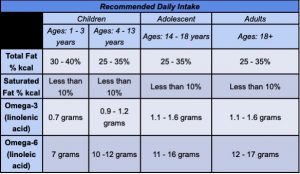
Omega-3 fatty acids
Omega-three fatty acids, also known equally alpha-linolenic acid, are 2 major classes of polyunsaturated fats. Omega-3 fatty acids play an important role in the diet for overall cell health and growth and include additional heart health benefits. 2 normally known omega-3 fatty acids are eicosapentaenoic acid (EPA) and docosahexaenoic acid (DHA) and are commonly plant in fatty fish similar salmon, sardines, and herring. Other sources of omega-iii fatty acids include flaxseeds, walnuts, soybean oil, and chia seeds.
The recommended daily intake of omega-3 fat acids for an individual's diet should make up nigh 0.six – 1.2% of overall total calories. Studies have shown that intake of omega-iii fatty acids, especially at least two EPA and DHA servings a week, tin reduce cardiovascular disease gamble.
Cholesterol – Fabricated by y'all for you!
Cholesterol is primarily produced by the body and is important for synthesizing Vitamin D, bile salts, and reproductive hormones. Cholesterol is likewise an essential component of the cell membrane. Minimal intake of cholesterol is consumed through food like animal sources, cheese, or egg yolks. An increased build-up of cholesterol tin contribute to the build-up of plaque and lead to many coronary avenue illness complications. Factors that tin contribute to high cholesterol include unhealthy eating habits with increased intake of processed and fried foods, lack of concrete activity, and smoking.
The liver produces lipoproteins that help carry fat and cholesterol through your bloodstream. 2 commonly discussed lipoproteins include depression-density lipoprotein (LDL) and high-density lipoprotein (HDL). LDL is known as the "bad" cholesterol and helps contribute to the build-up of plaque in your arteries' walls. HDL cholesterol is known as the "good" cholesterol and helps remove cholesterol and transport it back to the liver.
The Facts About Fat
- Recognize the structure of lipids. (MCCCD Competency 1)
- Discuss the four functions of fat. (MCCCD Competency 5)
- Identify the types of foods that contain various types of fat. (MCCCD Competency ii)
- Explicate the relation between dietary fat and associated health risks. (MCCCD Competency iv)
- Define monounsaturated fats, unsaturated fats, and saturated fats. (MCCCD Competency 5)
Source: https://open.maricopa.edu/nutritionessentials/chapter/lipids/
0 Response to "Saturated Lipids Saturated Lipids Found in Beef"
Post a Comment